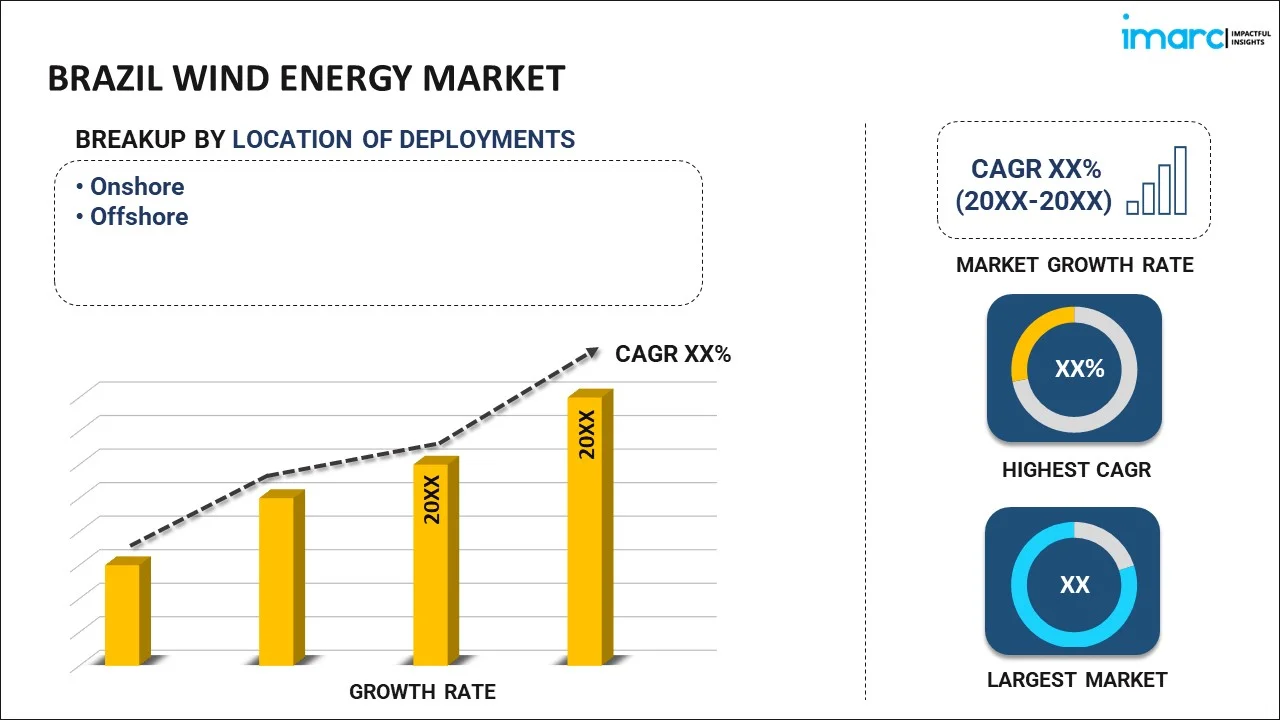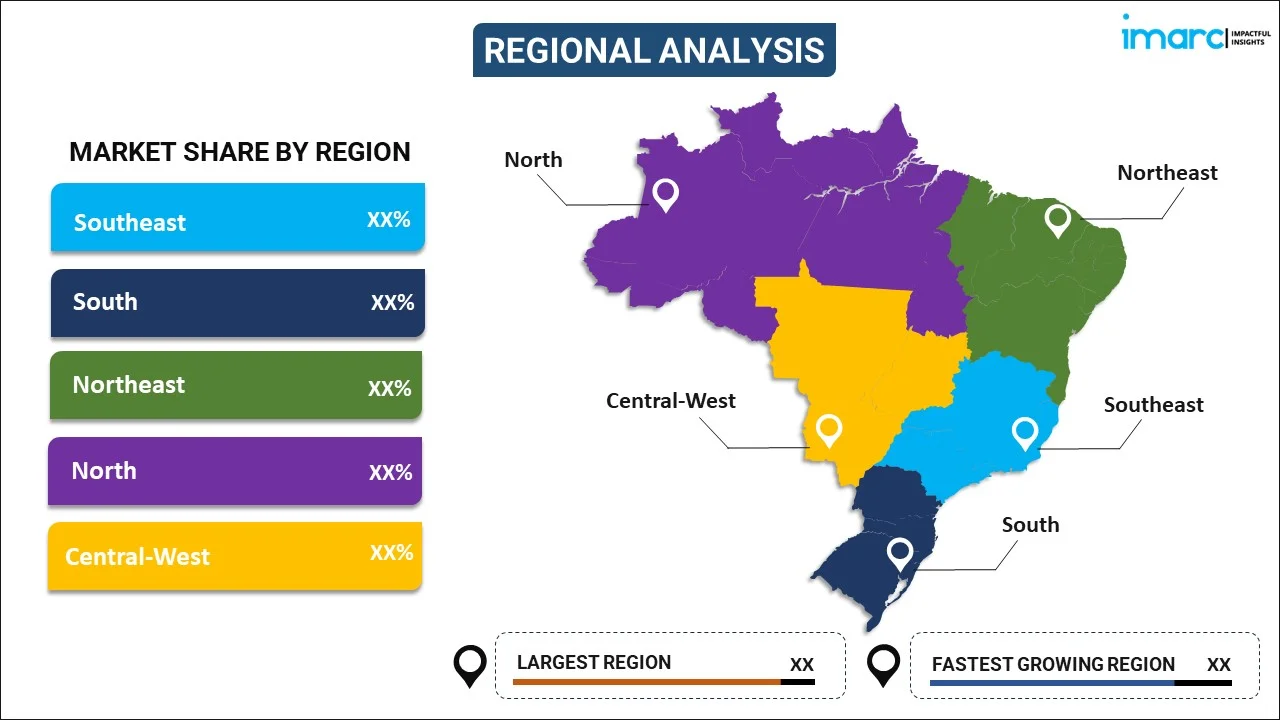
Brazil Wind Energy Market Report by Location of Deployment (Onshore, Offshore), and Region 2026-2034
Brazil Wind Energy Market Size:
Brazil wind energy market size reached USD 2,243.1 Million in 2025. Looking forward, IMARC Group expects the market to reach USD 4,438.8 Million by 2034, exhibiting a growth rate (CAGR) of 7.88% during 2026-2034. Factors like abundant windy resources, favorable government policies, technological advancements, surging energy demand, investment incentives, cost competitiveness, escalating environment concerns, and ambitious sustainability goals are influencing the market growth.
|
Report Attribute
|
Key Statistics
|
|---|---|
|
Base Year
|
2025
|
|
Forecast Years
|
2026-2034
|
|
Historical Years
|
2020-2025
|
|
Market Size in 2025
|
USD 2,243.1 Million |
|
Market Forecast in 2034
|
USD 4,438.8 Million |
| Market Growth Rate 2026-2034 | 7.88% |
Brazil Wind Energy Market Analysis:
- Major Market Drivers: Abundant resources, supportive government policies, advanced technology, and increasing demand for energy are the primary drivers bolstering Brazil wind energy market share. Moreover, these factors create a positive outlook for market expansion by making wind energy more viable and attractive.
- Key Market Trends: The main market trends include continuous technical developments relating to increasing turbine efficiency and/or integration of smart technology, and strong government support through an outreach mechanism such as energy auctions and incentives. Concurrent with this, the growing demand for sustainable energy, impelled by environmental concerns and international climate commitments is fostering market expansion.
- Geographical Trends: The Brazil wind energy market is predominantly centered in the Northeast region, due to their strong and consistent winds. Moreover, investments in infrastructure and grid integration are enhancing capacity, while regional policies support localized growth. Environmental and social considerations are increasingly prioritized, ensuring sustainable development across diverse regions.
- Competitive Landscape: The competitive landscape of the market has been examined in the report, along with the detailed profiles of the major players operating in the industry.
- Challenges and Opportunities: Brazil wind energy market analysis shows high upfront investments, complicated regulations, and possible negative environmental and social impacts of the large projects are some challenges impeding industry expansion. However, opportunities lie in source diversification, especially for offshore and onshore wind deployment around different regions and using local manufacturing capabilities in Brazil to bring down costs and raise competitiveness.
Brazil Wind Energy Market Trends:
Technological Advancements
Significant technological advancement and deployment of innovative wind turbine technology are aiding in market expansion. Significant improvements include larger, more efficient blades, better materials, and improved aerodynamic designs that significantly enhance the efficiency and resulting power output of the wind turbines. Moreover, the integration of smart technologies and digital tools into models of wind turbines has also cut operational costs and reduced downtime related to unabated monitoring and maintenance. These technological improvements therefore make wind energy more viable and competitive compared to traditional fossil fuels, driving their adoption and boosting investment in wind projects across Brazil.
Supportive Government Policies
Government policies and regulatory frameworks are instrumental in shaping the wind energy market in Brazil. The government of Brazil has introduced several initiatives aimed at incentivizing renewable energy, including wind power. The measures to put policies like Proinfa and the creation of energy auctions exclusively for wind power projects in place have instituted a stable and predictable environment within the market. Furthermore, tax incentives and subsidies were put in place that reduced barriers to entry and financial risks associated with wind energy projects along with streamlined procedures for permitting processes. These supportive measures have encouraged domestic and foreign investment in the wind energy industry's development, thereby creating a positive outlook for market expansion.
Growing Demand for Sustainable Energy
The high global and domestic demand for clean and sustainable sources of energy is another crucial factor driving the Brazilian wind energy market. With growing concern about climate change and associated environmental degradation, the emphasis has been on reducing greenhouse gas (GHG) emissions by switching to renewable sources of energy. The Brazilian commitment to international agreements on climate change, especially to the Paris Agreement, and goals regarding sustainable development and reduction of CO2 are aiding in market expansion. As per the Brazilian Wind Energy Association (ABEEólica), taking auctions and contracts into account, Brazil is expected to have at least 30 GW of installed wind-generating capacity by 2024. Moreover, wind energy offers a scalable and sustainable solution to meet the increasing energy demand in the country with minimal environmental damage.
Brazil Wind Energy Market Segmentation:
IMARC Group provides an analysis of the key trends in each segment of the market, along with forecasts at the country levels for 2026-2034. Our report has categorized the market based on the location of deployment.
Breakup by Location of Deployment:

To get more information on this market, Request Sample
- Onshore
- Offshore
The report has provided a detailed breakup and analysis of the market based on the location of deployment. This includes onshore and offshore.
Most of the onshore wind energy in Brazil is derived from already existing logistic and transport infrastructure, which again helps make the deployment of wind turbines easier and less expensive. This proximity to high-demand urban and industrial centers reduces transmission losses and associated costs. Furthermore, many onshore sites often have more established supply chains and a local workforce with experience, allowing projects to be executed and their operation at higher speeds, thereby making it a preferred location for deployment.
Besides this, there is an emerging trend towards offshore wind energy since the winds over the ocean are generally more powerful and reliable, which raises energy yield and system reliability. Moreover, large marine areas available also enable the installation of large projects without competing for land use. In addition to this, going offshore usually faces fewer obstacles regarding regulations and social issues connected with noise and scenery disruption than onshore farms, which further strengthens the market growth.
Breakup by Region:

- Southeast
- South
- Northeast
- North
- Central-West
The report has also provided a comprehensive analysis of all the major regional markets, which include Southeast, South, Northeast, North, and Central-West.
The Brazil wind energy market report exhibits high industrial energy demand, high population density in their centers, and the impetus to diversify energy sources due to low water levels affecting hydroelectricity is boosting the demand for wind energy in the Southeastern region.
In addition to this, the Atlantic coastline's strong, steady wind flows and already existing infrastructure set up the potential for the growth of wind energy in South Brazil to sustain regional economic growth and regional energy security.
Moreover, Northeast Brazil is an area of exceptional wind resources, government incentives, and strategic proximity to export markets; hence, it is the key to wind energy development and investment.
Concurrently, the push for wind energy in North Brazil is fueled by the need to complement hydropower during dry seasons, ensuring a stable and reliable energy supply in a region with fluctuating water levels.
Apart from this, with higher agricultural and industrial activity, wind energy also plays a vital role in diversifying the energy mix of Central-West Brazil, with less dependence on far-off energy imports, specifically by improving regional energy independence and stability.
Competitive Landscape:
- The market research report has also provided a comprehensive analysis of the competitive landscape in the market. Detailed profiles of all major companies have also been provided.
- The Brazil wind energy market forecast reveals that its competitive landscape is characterized by a diverse mix of domestic and international players vying for a share in one of the fastest-growing renewable energy sectors. Leading global companies compete with prominent Brazilian firms. These companies are attracted by Brazil's robust wind resources and favorable regulatory environment. The market is further influenced by a series of government-led energy auctions that ensure competitive pricing and stable returns on investment. Additionally, local manufacturing capabilities and supply chains are expanding, supported by policies encouraging domestic production of wind components. Collaboration between multinational corporations and local entities is common, facilitating technology transfer and skill development.
Brazil Wind Energy Market News:
- In June 2024, Chinese electricity company SPIC invested $147 million in the construction of two new wind farms in Northeastern Brazil, marking its debut in the country's solar sector. The new wind farms, which will have a combined installed capacity of 105.4 MW, will be built in Rio Grande do Norte state.
- In March 2023, Petrobras and Equinor signed an agreement to evaluate seven offshore wind projects in Brazil, with the potential to generate up to 14.5 GW. The partnership aims to advance Brazil's energy transition by creating the necessary initial conditions for renewable energy development in a sustainable way.
Brazil Wind Energy Market Report Scope:
| Report Features | Details |
|---|---|
| Base Year of the Analysis | 2025 |
| Historical Period | 2020-2025 |
| Forecast Period | 2026-2034 |
| Units | Million USD |
| Scope of the Report | Exploration of Historical Trends and Market Outlook, Industry Catalysts and Challenges, Segment-Wise Historical and Future Market Assessment:
|
| Location of Deployments Covered | Onshore, Offshore |
| Regions Covered | Southeast, South, Northeast, North, Central-West |
| Customization Scope | 10% Free Customization |
| Post-Sale Analyst Support | 10-12 Weeks |
| Delivery Format | PDF and Excel through Email (We can also provide the editable version of the report in PPT/Word format on special request) |
Key Questions Answered in This Report:
- How has the Brazil wind energy market performed so far, and how will it perform in the coming years?
- What are the drivers, restraints, and opportunities in the Brazil wind energy market?
- What is the impact of each driver, restraint, and opportunity on the Brazil wind energy market?
- What are the key regional markets?
- What is the breakup of the market based on the location of deployment?
- Which is the most attractive location of deployment in the Brazil wind energy market?
- What is the competitive structure of the market?
- Who are the key players/companies in the Brazil wind energy market?
Key Benefits for Stakeholders:
- IMARC’s industry report offers a comprehensive quantitative analysis of various market segments, historical and current market trends, market forecasts, and dynamics of the Brazil wind energy market from 2020-2034.
- The research report provides the latest information on the market drivers, challenges, and opportunities in the Brazil wind energy market.
- Porter's five forces analysis assists stakeholders in assessing the impact of new entrants, competitive rivalry, supplier power, buyer power, and the threat of substitution. It helps stakeholders to analyze the level of competition within the Brazil wind energy industry and its attractiveness.
- The competitive landscape allows stakeholders to understand their competitive environment and provides insight into the current positions of key players in the market.
Need more help?
- Speak to our experienced analysts for insights on the current market scenarios.
- Include additional segments and countries to customize the report as per your requirement.
- Gain an unparalleled competitive advantage in your domain by understanding how to utilize the report and positively impacting your operations and revenue.
- For further assistance, please connect with our analysts.
 Request Customization
Request Customization
 Speak to an Analyst
Speak to an Analyst
 Request Brochure
Request Brochure
 Inquire Before Buying
Inquire Before Buying




.webp)




.webp)












